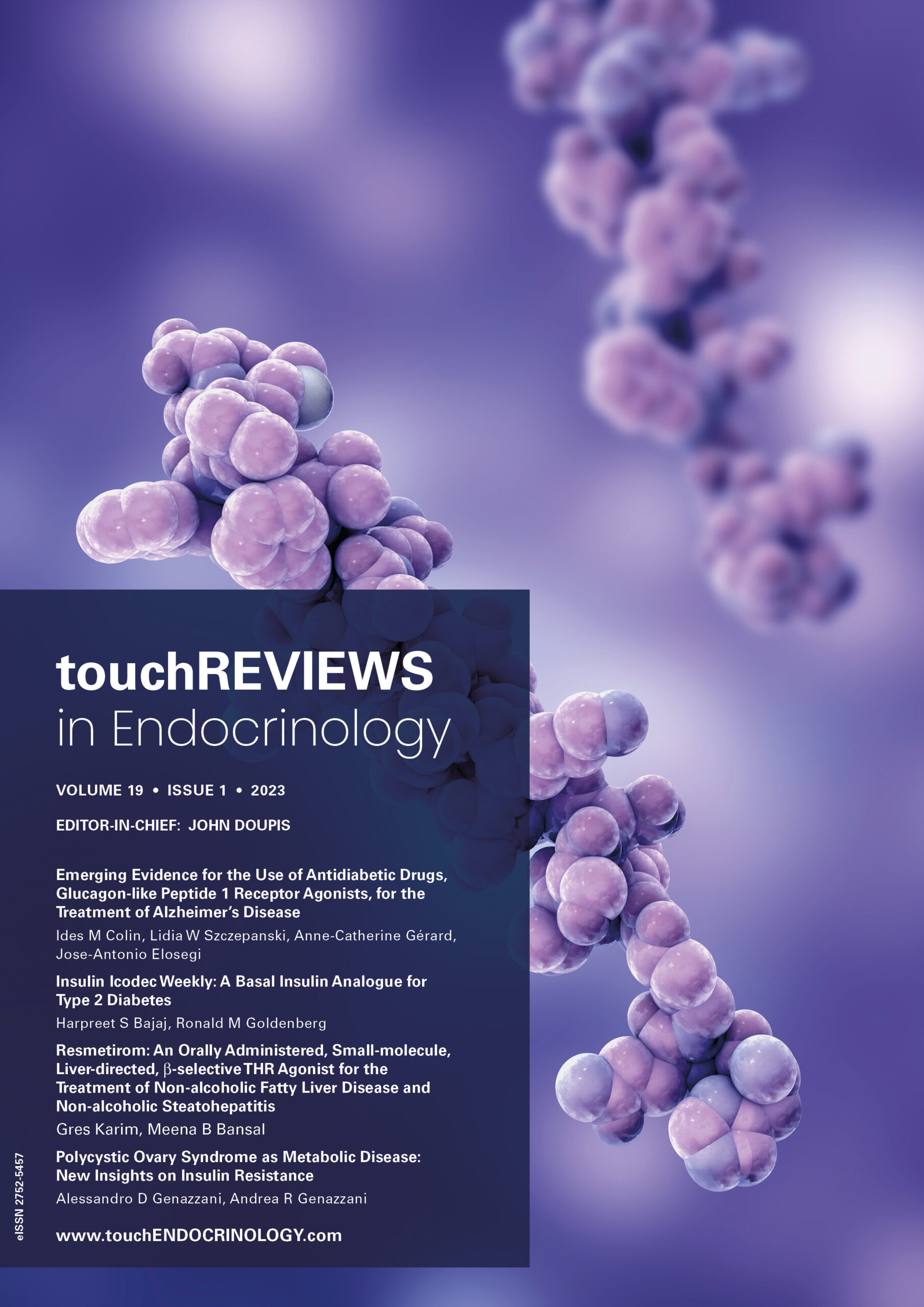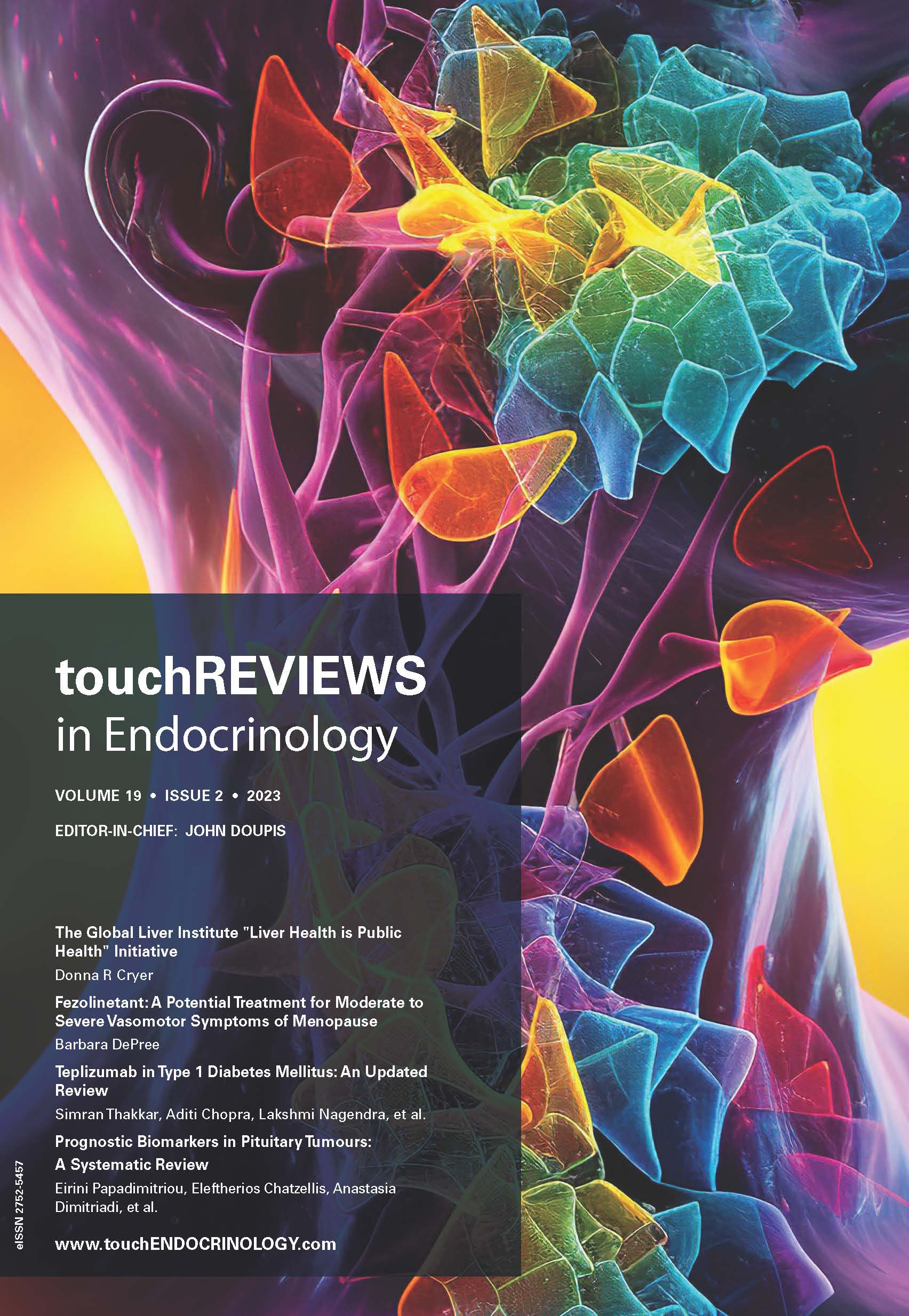touchREVIEWS in Endocrinology Volume 19, Issue 1, 2023
Welcome to the latest edition of touchREVIEWS in Endocrinology. In this edition, we feature a range of review, case report and original research articles that highlight some key developments in our understanding and management of endocrinological disease. With a strong focus on diabetes in this issue, a series of review articles covers different aspects of this complex multifactorial disease. Following this, an interesting selection of reviews, case studies and original research cover topics ranging from obesity, reproductive oncology, thyroid disorders, liver disorders and paediatric endocrinology.
We would like to take this opportunity to thank all who contributed towards this edition, in particular our authors, Editor-in-Chief, editorial board members and partners.
We are now welcoming submissions to our 2023/2024 editions. If you’re interested in submitting an article, please get in touch!
Enjoy and happy reading!
Foreword
Welcome to the latest edition of touchREVIEWS in Endocrinology. In this edition we feature a range of review, case report and original research articles that highlight some key developments in our understanding and management of endocrinological disease. We start with a focus on diabetes. An editorial from Bhattacharya and Kalra gives an overview of the […]
Editorials
The American Association of Clinical Endocrinology (AACE) recently released a comprehensive and updated guideline on the prevention and management of diabetes.1 The guideline is aimed at assisting healthcare professionals in delivering person-centred optimal care at different phases of diabetes. The statement comprises 170 evidence-based recommendations divided into four sections. Noteworthy additions There are several new and noteworthy updates […]
Insulin remains an important diabetes treatment, with 150–200 million people worldwide requiring insulin therapy.1 While insulin is vital for managing type 1 diabetes, basal insulin is typically recommended for type 2 diabetes when non-insulin therapies are not enough to achieve glycaemic targets.2 Several barriers related to basal insulin therapy for type 2 diabetes contribute to non-achievement of glycaemic targets, including delay of insulin initiation or […]
Reviews
Worldwide prevalence of type 2 diabetes mellitus (T2DM) is steadily increasing due to rising levels of obesity over the past 40 years caused by sedentary lifestyles and unhealthy eating habits. Diabetes now ranks ninth among the top ten causes of death worldwide, and the disability adjusted life years (DALYs) has increased more than 80% between […]
Type 2 diabetes (T2DM) is a disease with a complex aetiopathogenesis that leads to a wide variety of metabolic disorders. This includes, by definition, high plasma glucose levels, but also elevated blood pressure, dyslipidaemia, cardiorenal complications and strokes. All of these disorders, beyond the progressive beta cell failure, derive from insulin resistance (IR).1 Among the many […]
Type 2 diabetes mellitus (T2DM) is a severe public health issue notably impacting human life and health expenditure. Around 9.3% (463 million people) of the global population were living with diabetes in 2019, and this is projected to increase to 10.2% (578 million people) by 2030 and 10.9% (700 million people) by 2045.1,2 Diabetes impacts functional […]
Diabetes affects an estimated 537 million adults and was responsible for 6.7 million deaths in 2021, worldwide.1 The International Diabetes Federation estimates that 3 out of 4 adults with diabetes live in low- and middle-income countries.1 Southeast Asia alone accounts for 90 million patients, of whom only half are aware of their diabetes.2 Five decades ago, type 2 diabetes mellitus was a rare disease, affecting just 1% of the population.3 Most people with type 1 diabetes had autoimmune insulin deficiency and would […]
The incidence of youth-onset type 2 diabetes (T2D) is increasing.1,2 Growing evidence has demonstrated that youth-onset T2D is rapidly progressive, with earlier onset of life-limiting complications compared with adult-onset T2D.3,4 Initiation of effective treatment that can restore beta cell function is critical. Until 2019, metformin and insulin were the only medications approved by the United States […]
Article highlights Epigenetics refers to the heritable changes in DNA expression without changes in the genetic code. Epigenetic changes are brought about by post-translational modifications of histone proteins, covalent modifications of DNA bases and microRNA. Epigenetics explains how environmental milieu such as diet, physical activity, circadian rhythm, intrauterine malnutrition or maternal obesity interact with the genome of […]
Obesity is related to an increased risk of metabolic disease.1 It is well established that excessive body fat is related to increased morbidity and mortality and is associated with inflammation and endothelial damage.2,3 With age, fat infiltration occurs in the muscle, leading to sarcopenia. The association of the excessive accumulation of adipose tissue with a progressive decrease […]
Non–alcoholic fatty liver disease (NAFLD) encompasses a spectrum of fatty liver diseases, including non–alcoholic fatty liver (NAFL) and non–alcoholic steatohepatitis (NASH).1 NAFLD is associated with metabolic disorders, including obesity, hypertension, dyslipidaemia, type 2 diabetes mellitus (T2DM), hypothyroidism and metabolic syndrome.2 The diagnosis of NAFLD requires ≥5% histologic or imaging evidence of hepatic steatosis, with exclusion of secondary causes of hepatic steatosis, such as significant alcohol consumption, hereditary disorders and […]
Polycystic ovary syndrome (PCOS) is a very common disease, with an incidence of 5−21% in women during their fertile life (18–45 years of age) worldwide.1 PCOS is clinically diagnosed when two of the three 2003 Rotterdam consensus criteria are met: (i) chronic anovulation disorder (in the form of oligo- or anovulation up to amenorrhoea); (ii) clinical (e.g. […]
Thyrotoxicosis refers to the signs and symptoms derived from excess circulating thyroid hormones in the body,1 which must be differentiated from hyperthyroidism, in which there is an increase in the synthesis and secretion of hormones by the thyroid gland.2 Approximately 1% of patients with thyrotoxicosis develop thyrotoxic cardiomyopathy (TCM), which is a rare but potentially lethal form […]
Original Research
Diabetic foot ulcers are one of the major complications in patients with diabetes mellitus (DM). In one study, the global prevalence of diabetic foot ulcers was 6.3%, and the prevalence of diabetic foot ulcers differed between North America (13.0%) and Europe (5.1%).1 Besides lowering quality of life, diabetic foot ulcers and diabetic foot amputations are a huge financial […]
Case Reports
Bladder cancer (BC) is the second most commonly diagnosed urological neoplasm worldwide.1 Approximately 10–15% of patients already have metastases in lymph nodes, lungs, liver and bones at diagnosis.2,3 Metastatic BC has a poor prognosis, with a 5-year overall survival (OS) rate of 10% and median OS of only 15 months.4–6 The vast majority (>90%) of BCs are urothelial […]
Hypothyroidism usually presents with subtle signs and symptoms. Rarely, longstanding juvenile hypothyroidism can manifest as a syndromic diagnosis of Van Wyk–Grumbach syndrome (VWGS).1 VWGS presents as early menarche, thelarche, galactorrhoea, delayed bone ageing and multi-cystic ovaries, along with long-standing primary hypothyroidism.2 Reversal to the prepubertal state is typically seen following the appropriate treatment with levothyroxine. The present […]
Thyrolipomatosis is a rare condition defined as a diffuse non-neoplastic infiltration of fatty tissue in the thyroid gland.1 Although fatty infiltration is common in other glands (e.g. salivary glands, parathyroids, thymus and pancreas), it is rare in the thyroid gland.2 If present, it is most frequently nodular (i.e. thyrolipoma) rather than diffuse (i.e. thyrolipomatosis).3 Thus, since the first […]

Trending Topic
Thyroid eye disease (TED), also known as Graves’ orbitopathy, is a complex autoimmune disorder driven by an interplay of immune cells, orbital fibroblasts and tissue remodelling factors that lead to inflammation, oedema and, ultimately, potential vision loss.1 While the disease has historically been challenging to manage, recent therapeutic innovations are reshaping treatment paradigms and offering new […]
Journal Archive
touchREVIEWS in Endocrinology (previously European Endocrinology) is a peer-reviewed, free-to-access, bi-annual journal comprising review articles, case reports, editorials, special reports and original research. It features balanced and comprehensive articles written by leading authorities, addressing the most important and salient developments in the field of endocrinology.
Latest articles videos and clinical updates - straight to your inbox
Log into your Touch Account
Earn and track your CME credits on the go, save articles for later, and follow the latest congress coverage.
Register now for FREE Access
Register for free to hear about the latest expert-led education, peer-reviewed articles, conference highlights, and innovative CME activities.
Sign up with an Email
Or use a Social Account.
This Functionality is for
Members Only
Explore the latest in medical education and stay current in your field. Create a free account to track your learning.






















